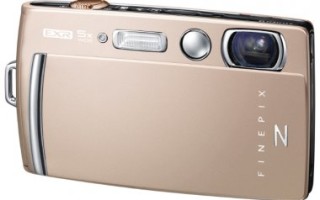Fujifilm FinePix Z1000EXR review
Fujifilm FinePix Z1000EXR

- Autofocus type: contrast
- Number of groups of optical elements: 13
- Number of optical elements: 11
- Digital Zoom: 2x
- Optical Zoom: 5x
- Focal length: 28 - 140 mm
- Aperture: F3.9 - F4.9
- Number of effective megapixels of the matrix: 16 million
- Physical matrix size: 1/2″ null,1,”11218
- Matrix type: CMOS
Buy
Here you can watch a video review of the Fujifilm FinePix Z1000EXR. Find out the characteristics, read reviews about the Fujifilm FinePix Z1000EXR.
Stores where you can buy this product and its analogues
Video reviews of Fujifilm FinePix Z1000EXR
- All 10
- Setting 1
 Fujifilm FinePix Z1000EXR Digital Camera
Fujifilm FinePix Z1000EXR Digital Camera
Specifications Fujifilm FinePix Z1000EXR
* Check with the seller for exact specifications.
Lens
| Autofocus type | contrasting |
| Number of groups of optical elements | 13 |
| Number of optical elements | 11 |
| Autofocus illuminator | There is |
| Face focusing | There is |
| Digital Zoom | 2x |
| Optical Zoom | 5x |
| Focal length | 28 - 140 mm |
| Diaphragm | F3.9 - F4.9 |
Matrix
| Number of effective megapixels of the matrix | 16 million |
| Physical matrix size | 1/2″ null,1,”11218 |
| Matrix type | CMOS |
| Number of megapixels of the matrix | 16 million |
| Maximum resolution | 4608 x 3456 |
| Sensitivity | 100 - 3200 ISO, Auto ISO |
| Extended ISO values | ISO6400 |
Viewfinder and screen
| LCD screen | 460000 dots, 3.50 inches |
| Using the screen as a viewfinder | There is |
| Viewfinder type | absent |
| LCD Screen Type | sensory |
Excerpt
| Manual shutter speed and aperture settings | No |
| Excerpt | 4 - 1/2000 s |
Light control
| Exposure compensation | +/- 2 EV in 1/3 stop increments |
| Exposure metering | multizone, center-weighted, spot |
White balance
| White balance | automatic, from the list |
Flash
| Flash | built-in, up to 3.70 m, red-eye reduction |
Stabilization
| Image stabilizer (still photography) | optical, matrix shift |
Video and sound recording
| Max. video frame rate | 30fps |
| Max. video resolution | 1920×1080 |
| Video recording | There is |
| Sound recording | There is |
| Maximum frame rate when shooting HD video | 25/30 fps at 1280x720 resolution, 25/30 fps at 1920x1080 resolution |
| Video codecs | MPEG4 |
Interfaces and memory
| Built-in memory size | 62 MB |
| Memory card type | SD, SDHC, SDXC |
| Image formats | JPEG |
| Interfaces | USB 2.0, HDMI, Wi-Fi |
Shooting speed and modes
| Timer | There is |
| Macro photography | There is |
| Frame format (still photography) | 4:3, 3:2, 16:9 |
Nutrition
| Battery capacity | 220 photos |
| Number of batteries | 1 |
| Battery type | your own |
Dimensions
| Weight (without batteries) | 141 g, without batteries; 157 g, with batteries |
| Size | 102x60x18 mm |
Additional Information
| Camera type | compact |
| Equipment | battery, charger, USB cable, wrist strap, instructions, CD with software |
| Additional features | tripod mount, orientation sensor |
* Check with the seller for exact specifications.
Pros and cons of Fujifilm FinePix Z1000EXR
compact, bright and beautiful photographs on the street, turned on by sliding the lid, i.e. It just won’t turn on, the lens won’t extend, convenient control on the touch screen.
To take normal photos at home I had to train for a couple of days, but even that was achievable. Having my own battery is of course an advantage for me, but it’s not very powerful, so the next day we bought a spare one.
Reviews of Fujifilm FinePix Z1000EXR
Thank you, your review will appear on the site soon.
Fujifilm FinePix Z1000EXR - technology and style
Fujifilm Press Release
Fujifilm FinePix Z1000EXR: constant style
Fujifilm Z series cameras traditionally combine advanced technology with modern and stylish design. The newest camera in the line, the Z1000EXR, is no exception. The Z1000EXR features a sleek design, a 16-megapixel EXR CMOS sensor and the latest Fujifilm technologies to deliver superior shooting results every time.
Additionally, the Z1000EXR features Wireless Image Transfer, allowing users of Android™ or iOS™ smartphones or tablets (iPhone™ and iPad™) to connect to the camera and upload high-quality images to social media sites in seconds .
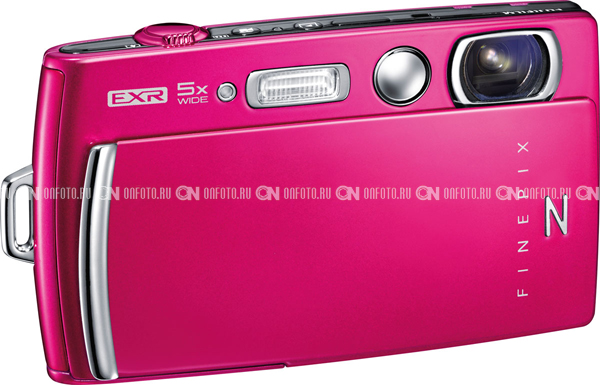
Perfect quality
The Z1000EXR's 16 megapixel EXR CMOS sensor delivers stunning results no matter the shooting conditions. The EXR CMOS sensor has been redesigned to prioritize light sensitivity. Digital noise levels are reduced by 30% compared to its predecessor, allowing higher ISO levels to maintain soft tones not only in brightly lit areas, but also in shaded areas.
Fujifilm's popular EXR AUTO mode independently assesses the lighting level, sets the type of scene, and tracks the movement and location of subjects in the frame. The mode uses Advanced Anti Blur technology and selects from three optimized settings: High Resolution Priority for well-lit subjects and optimal image quality, and Dynamic Range Priority for high-contrast subjects. scenes and shoot with High Sensitivity and Low Noise Priority for clear images with soft tones when shooting in low-light conditions. Users can also choose their own shooting modes, but with an Intelligent Auto mode that detects up to 103 types of scenes, they are unlikely to need it!
Always in touch
The Z1000EXR camera allows you to quickly upload photos to social networking sites without losing image quality. The camera connects to any Android™ or iOS™ smartphone or tablet by downloading the free FUFJIFILM Photo Receiver app to your device and following simple instructions.
To start downloading, click on the FinePix Z1000EXR touch screen icon to connect to your smartphone. Photos will be transferred to a smartphone or tablet for subsequent uploading to social networking sites.
The Z1000EXR uses state-of-the-art image processing technology, and the camera's menu system is intuitive and easy to operate. The camera's 3.5-inch LCD display offers touch control with smartphone-like navigation capabilities. Plus, the 460,000 dot screen resolution ensures exceptional clarity when viewing photos and videos or when choosing the composition of a shot.
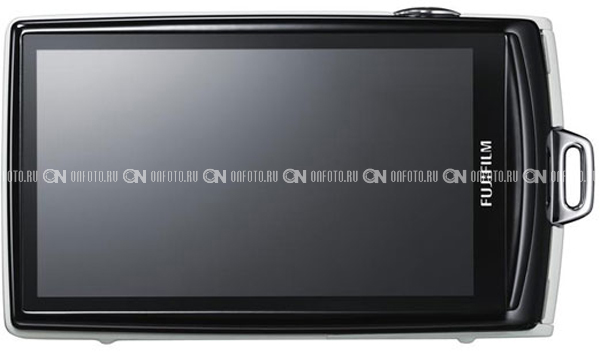
Flawless Portrait
The Z1000EXR offers several features to enhance the appearance of people in photographs using advanced imaging technologies. Face tracking, created by combining face detection technology and autofocus tracking, ensures that your subject is captured clearly even while it moves. The camera is equipped with a wide-angle framing assist mirror designed to display the entire scene when users take pictures of themselves.
For couples and group photos, the Z1000EXR features innovative self-timer technology. When the Couple Timer is activated, a photo is taken when two faces come close to each other, and when the Self portrait Timer is activated, the camera can detect up to four faces—giving users time to prepare when taking photos with friends or family. close-up photography.
The process of improving image quality continues after you press the shutter button. After taking a photo, users can use facial retouching functions (straightening/brightening/enlarging eyes) to enhance the appearance of the subject.
Choose your own shooting style
The Z1000EXR is designed for more than just photography—it can record Full HD video at 30 frames per second for sharp clarity and smooth gradations. The Fujinon 5x optical zoom lens and face-tracking autofocus lock in all subjects and keep them in frame throughout the shoot, no matter how you move or recompose the shot. Stereo sound makes videos more realistic, and the mini HDMI port makes it easy to view photos and videos on a high-definition TV.
The Intelligent Digital Zoom function allows you to increase the focal length of the optical zoom. The camera independently evaluates areas of the image and selectively applies image processing technology to increase the focal length by 10 times without losing quality, which is not usually possible with digital zoom. For close-up photography, the Z1000EXR provides a minimum focal length of 9cm for colorful, highly detailed macro images.
Technology and style
The FinePix Z1000EXR uses innovative photographic technology to deliver an impeccable design. At just 18mm thick, the Z1000EXR is sleek, elegant and easy to use.
The camera comes in four exquisite colors: pink, golden cream, jade and white.
Fujifilm FinePix Z1000EXR camera review: now with Wi-Fi
 Price: 8990 rub.
Price: 8990 rub.
My regular readers are probably aware that lately I have become very fond of Fujifilm photographic equipment. The best mirrorless camera, the best compact point-and-shoot camera - that's all of them. I’ll write about the X-S1 ultrasonic a little later, but for now I want to talk about the “beauty bag companion” – the FinePix Z1000 model. This camera belongs to the category of cameras from which good quality images are not required - there are different criteria here. Compact, glamorous (in the good sense of the word), easy to use. Well, durability doesn't hurt either. And there is also Wi-Fi here.
The Z1000 is a device with almost entirely touch controls. I'd say it's a lot like Sony's point-and-shoot cameras. In general, Fujifilm equipment can competently “remind”. The X10 is reminiscent of Leica, the X-S1 is reminiscent of Nikon DSLRs. This is a very smart move by the manufacturer - after all, there is no direct copying, the equipment is simply “vaguely similar.” At the same time, it looks exactly like a product with a similar (or close to it) positioning. So it is here: the Z1000 is intended, first of all, for handbags and, I must say, it looks great in them. Although, why only ladies? Fans of ultra-compacts - come on!
Specifications
| Sensor | CMOS, 1/2″ (CROP factor 5.41) |
| LCD screen | 3.5'', 460,000 pixels, touch |
| File formats | JPEG |
| Image resolution | 4608 x 3456 |
| Video | H.264 (MOV), 25/30 fps, audio recording (stereo), Full HD |
| Lens | 28 – 140 mm (35 mm equivalent), F3.9 – F4.9 |
| Minimum shooting distance | 0.09 m |
| Dimensions and weight | 102 x 60 x 18 mm, 157 g (with battery and memory card) |
| Memory | SD/SDHC/SDXC + built-in memory (62 MB) |


Comparison of dimensions of Fujifilm FinePix Z1000 and Sony Xperia S smartphone
Of course, for all its elegance, the device is still a bit thick for an ultra-compact. The same Sony has lighter and thinner devices, but more expensive and without Wi-Fi.

There is a mini-HDMI connector and proprietary USB - like other Fujifilm

Slot for SD card (full size) and branded battery

Buttons: “playback”, “video” and shutter release along with a zoom control. There are no more buttons on the camera.
What else can I say about the appearance... The lens opens (and the camera turns on) by moving the curtain down. The mechanism is quite familiar. Under the curtain, in addition to the lens, you can see a xenon flash and a mirror - with its help it is convenient to take self-portraits, including “duckface with a friend” (homework - find duckface and a friend in the photographs below):


Screen and interface
The most interesting thing about the Z1000 screen is that it is a resistive touch screen and at the same time supports multi-touch (as I have already described as possible). Multi-touch here is expressed in the already familiar pinch gestures for scaling a photo when viewing. However, of course, the resistive sensor is a minus. Firstly, the sensitivity is worse than that of a capacitive screen, and secondly, the coating is clearly not glass, and therefore can get scratched very quickly. Of course, film will save him, but at the same time it will worsen his already low sensitivity.
But the interface is clear and simple. A minimum of settings and almost everything you need fits on one screen. In this sense, Fujifim's interface designers have gone far ahead compared to Sony.


Photos
So we have lived to see that happy moment when simple digital point-and-shoot cameras are in no way inferior in quality to telephones. No... somehow I said it wrong - on the contrary it should be. However, it doesn't matter.
The dynamic range of the Z1000 is quite expectedly poor. Well, what did you want: a small sensor, a dark lens.
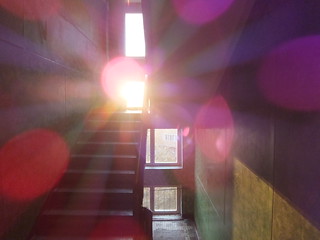



Pay attention to the unnatural lighting of the fence:

5x optical zoom can be thought of something like this:


The camera can even do something like macro - in a special mode you can shoot from 9 mm:


As I already said, the lens is quite dark. Once the sun hides behind the gray clouds, it becomes difficult to remove something in the shade of trees from your hands without smearing: 
Another drawback of the Z1000 is the “barrel”: 
However, it is worth noting that the target audience is unlikely to find fault with this.
However, where the camera shows good results is in the almost complete absence of lighting. Of course, the ISO rises to unimaginable levels (1600), however, Fujifilm's proprietary noise reduction can at least improve the situation a little. For such a soap dish - quite. 


Shooting video
The Fujifilm FinePix Z1000 can shoot Full HD video at 30 frames per second in MPEG4 (.MOV) format.
During the day it looks something like this:
As you can see, autofocus has problems at night - but this is quite expected.
I know some readers have been waiting for this particular paragraph. Well – Wi-Fi is Wi-Fi. The implementation is very strange, but...
In general, the camera can pretend to be an access point. For what? Wait, don’t interrupt - in order for this access point to be of any use, you need to download the Fujifilm Photo Reciever or Fujifilm Camera Application to your phone (there are versions for Android and iOS, I couldn’t find them for other systems) and then click the “Connect” button. ).


In this simple way you can send photos to your phone. One by one. Hmmm... By the way, the Fujifilm Camera Application is more functional than Photo Reciever - you can view the entire memory of the camera. In theory. Practically, I racked my brains, but still couldn’t find how to do it. However, the question arises: why do we need a second application? Well, this is apparently a typical confusion with Fujifilm software - their Mac version of the My FinePix Studio utility still only exists in a version for PowerPC.
In general, I wouldn’t seriously consider Wi-Fi as an advantage. Now, if you could upload photos to Dropbox, it would be more interesting. The same upload to Facebook and YouTube is only available through the PC application: first, on the camera itself, put the “upload there” tag, then, when importing to the PC, the photos are uploaded. For the post-PC era, this is completely uninteresting. So although Fujifilm is the best with filters and image processing, they are not good with network technologies and software.
Battery
An important factor is battery life. This is where I really liked the Z1000. Unlike most soap dishes, the battery charge of which simply melts before our eyes, during the entire testing period I did not have to recharge it even once - it only discharged at the end of testing. Not a bad result.
Pros and cons
Behind
- Good design
- Long (relative to competitors) battery life
- Mirror for self-portraits
- User-friendly interface
- Good video quality
Against
- Large (relative to competitors) dimensions and weight
- “Barrel” at a wide angle
- Dark lens
Total
The Fujifilm FinePix Z1000 is inferior to more expensive cameras from Sony, perhaps in size (that is, on the contrary - Fujifilm is larger), but not in image quality. At the same time, Fujifilm, despite the clearly “girly” positioning, does not strive to raise the colors to acidic shades - honesty for the camera is above all. Of course, a dark lens will create difficulties when shooting in cloudy weather in the forest, but, alas, inexpensive point-and-shoot cameras are now more and more different from more expensive compacts and are somewhere close to phones in quality. But what phones definitely don’t have is optical zoom, and sometimes you need it.
As for the touch screen, it’s a matter of taste and color, as they say. The main advantage of this approach: you can make a large screen, you don’t need to allocate space for buttons.
Post published by Denis Popovkin. You can comment here or there.
Fujifilm FinePix Z1000EXR review
Fujifilm Z series cameras traditionally combine advanced technology with modern and stylish design. The newest camera in the line, the Z1000EXR, is no exception. The Z1000EXR features a sleek design, a 16-megapixel EXR CMOS sensor and the latest Fujifilm technologies to deliver superior shooting results every time.
Additionally, the Z1000EXR features Wireless Image Transfer, allowing users of Android™ or iOS™ smartphones or tablets (iPhone™ and iPad™) to connect to the camera and upload high-quality images to social media sites in seconds .
Perfect quality
The Z1000EXR's 16 megapixel EXR CMOS sensor delivers stunning results no matter the shooting conditions. The EXR CMOS sensor has been redesigned to prioritize light sensitivity. Digital noise levels are reduced by 30% compared to its predecessor, allowing higher ISO levels to maintain soft tones not only in brightly lit areas, but also in shaded areas.
Fujifilm's popular EXR AUTO mode independently assesses the lighting level, sets the type of scene, and tracks the movement and location of subjects in the frame. The mode uses Advanced Anti Blur technology and selects from three optimized settings: High Resolution Priority for well-lit subjects and optimal image quality, and Dynamic Range Priority for high-contrast subjects. scenes and shoot with High Sensitivity and Low Noise Priority for clear images with soft tones when shooting in low-light conditions. Users can also choose their own shooting modes, but with an Intelligent Auto mode that detects up to 103 types of scenes, they are unlikely to need it!
Always in touch
The Z1000EXR camera allows you to quickly upload photos to social networking sites without losing image quality. The camera connects to any Android™ or iOS™ smartphone or tablet by downloading the free FUFJIFILM Photo Receiver app to your device and following simple instructions.
To start downloading, click on the FinePix Z1000EXR touch screen icon to connect to your smartphone. Photos will be transferred to a smartphone or tablet for subsequent uploading to social networking sites.
The Z1000EXR uses state-of-the-art image processing technology, and the camera's menu system is intuitive and easy to operate. The camera's 3.5-inch LCD display offers touch control with smartphone-like navigation capabilities. Plus, the 460,000 dot screen resolution ensures exceptional clarity when viewing photos and videos or when choosing the composition of a shot.
Flawless Portrait
The Z1000EXR offers several features to enhance the appearance of people in photographs using advanced imaging technologies. Face tracking, created by combining face detection technology and autofocus tracking, ensures that your subject is captured clearly even while it moves. The camera is equipped with a wide-angle framing assist mirror designed to display the entire scene when users take pictures of themselves.
For couples and group photos, the Z1000EXR features innovative self-timer technology. When the Couple Timer is activated, a photo is taken when two faces come close to each other, and when the Self portrait Timer is activated, the camera can detect up to four faces—giving users time to prepare when taking photos with friends or family. close-up photography.
The process of improving image quality continues after you press the shutter button. After taking a photo, users can use facial retouching functions (straightening/brightening/enlarging eyes) to enhance the appearance of the subject.
Choose your own shooting style
The Z1000EXR is designed for more than just photography—it can record Full HD video at 30 frames per second for sharp clarity and smooth gradations. The Fujinon 5x optical zoom lens and face-tracking autofocus lock in all subjects and keep them in frame throughout the shoot, no matter how you move or recompose the shot. Stereo sound makes videos more realistic, and the mini HDMI port makes it easy to view photos and videos on a high-definition TV.
The Intelligent Digital Zoom function allows you to increase the focal length of the optical zoom. The camera independently evaluates areas of the image and selectively applies image processing technology to increase the focal length by 10 times without losing quality, which is not usually possible with digital zoom. For close-up photography, the Z1000EXR provides a minimum focal length of 9cm for colorful, highly detailed macro images.
Technology and style
The FinePix Z1000EXR uses innovative photographic technology to deliver an impeccable design. At just 18mm thick, the Z1000EXR is sleek, elegant and easy to use.
The camera comes in four exquisite colors: pink, golden cream, jade and white.
Fujifilm FinePix Z1000EXR Review
Latest Reviews Popular Reviews

![]()




![]()



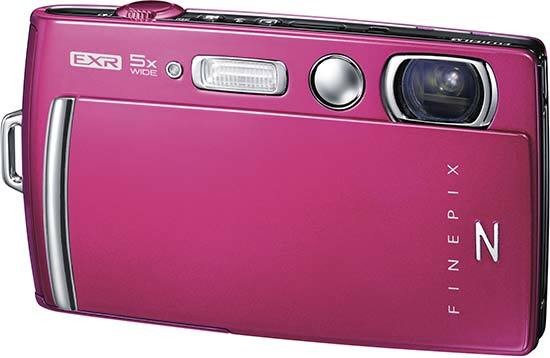
Introduction
The new Fujifilm FinePix Z1000EXR is a stylish digital camera with a lot of features packed into its slim frame. Sporting a 16 megapixel back-illuminated (BSI) EXR-CMOS sensor, 5x optical zoom, 3.5 inch touch screen LCD, Wireless Image Transfer to smartphones and social networking sites, full 1080p HD movie capture with stereo sound, sensor shift image stabilization, top ISO 6400 sensitivity, 1600% dynamic range and up to 12 frames per second continuous shooting, on paper the Z1000EXR seems to be too good to be true. The Fujifilm FinePix Z1000EXR costs £199.99 / $279.95 and is available in pink, white or green.
Ease of Use
The Z1000EXR's lens sits in the top right of the camera (if viewed from the front) with a large plate of metal sliding over it to protect it and also power the camera on and off. The review model that we tested was the bright pink version which has a very smooth and glossy coating. With only a small, super-slim silver handgrip on the front, this does make the Z1000EXR rather difficult to hold steady. A clever addition to the Z1000EXR is a small mirror, essentially a poor man's version of the secondary LCD screen found on the front of Samsung Dual-View cameras, but proving almost as effective in practice. The AF assist lamp and built-in flash complete front of the Z1000EXR.
On the Fujifilm FinePix Z1000EXR's top plate, there's the shutter release with the zoom switch wrapped around it and a direct video record button for those candid moments so you don't have to go into menus and switch on the video mode first. The Z1000EXR records video in the H.264 format and you can tag videos in camera for easy upload to YouTube, something that the younger generation may prefer but that's not to say that it's off limits to anyone else. A new addition to the top of the camera is a small playback button.
One of the most important new features on the Z1000EXR is the Wireless Image Transfer functionality. By installing the free Photo Receiver app on your smartphone, connecting to the camera's wi-fi network, then pressing Connect simultaneously on both devices, you can transfer images from the Z1000EXR to an Android or iOS device and then edit and share the images as you wish. Up to 30 images can be transferred at one time. In practice it's a little laborious to get started, and we'd also liked to be able to connect to any wi-fi network, not just a smartphone, but it does at least provide an easy way to get the images off the camera and onto a device or website of your choice.
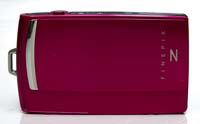 |
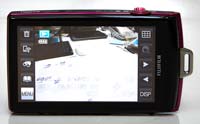 |
| Front | Rear |
The Z1000EXR has a BSI EXR-CMOS sensor. BSI stands for Back Side Illuminated which means that all the circuitry that normally surrounds each pixel has been placed on the back of the sensor. This technique exposes the full sensor to light meaning that it's more responsive in low light situations and a lower ISO can therefore be used. The back of the sensor isn't actually illuminated, the sensor gets it's name from when it's fitted to the camera. Because the circuitry is on the back, it looks as though the sensor is fitted backwards so the back side gets illuminated by light from the lens.
EXR is a processor and sensor system designed to increase the resolution, produce better colors, lower noise and be an all round good egg. It's certainly shown a lot of promise in the past with the cameras that have been fitted with it. For those of you that aren't photographically astute, there are two types of sensor that are frequently used in digital cameras. The traditional variety is the CCD (Charge Coupled Device) offering a sharp image but has a higher fuel consumption than CMOS (Complementary Metal Oxide Semiconductor) which gives a slightly softer result but is more efficient. Fujifilm have opted for the CMOS in the Z1000EXR believing that it works better with the EXR processor.
Fujifilm's EXR sensor can be used in one of three ways by the photographer. There's a choice between shooting at full 16 megapixel resolution in High Resolution (HR) mode, or an 8 megapixel image in the Low Noise (SN) mode for shooting without flash in low light conditions, or the Dynamic Range (DR) mode to achieve an optimal balance between shadows and highlights. The latter offers five strengths ranging from 100-1600%. If you can't decide which is best for a chosen scene or subject, then just leave the camera on the scene-detecting EXR Automatic Mode and let it choose for itself. The Pro Low-light mode uses multi-bracketing technology, taking a series of four high sensitivity/low-noise shots in quick succession and combining them into an image with less noise than the single exposures.
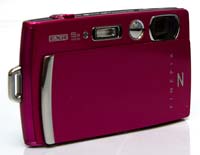 |
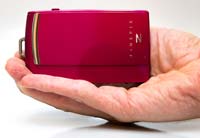 |
| Front | Front |
Thanks to the 5x optical zoom of the Fujifilm FinePix Z1000EXR being internal, the body of the camera is very slim. It makes the camera easily pocketable and of course should a child get hold of it, there's no chance of them breaking the zoom barrel. All other buttons and functions except for the three controls on the top of the camera have been incorporated into the touch screen interface, so if you're a fan of external controls then this isn't the camera for you.
The build quality of the Z1000EXR is very good. The camera feels solid to hold and the large plate that covers the lens should provide exceptional protection. The only thinga we're disappointed in are located on the bottom of the camera — there's a cheap plastic tripod bush and the battery door is quite flimsy. Generally, higher specification cameras have a metal tripod bush and it's kind of like a status symbol with manufacturers. With regards to the battery door, it's not that problematic but it's not the easiest door to open and that gives us concern with long time usage.
Fujifilm have changed the way that their menus work these days. Before, it was a simple combination of shooting menu and set up menu with a separate playback menu in that mode. While it's technically the same at its base elements, the structure of it has changed so it seems more difficult to operate. The modes are now found by pressing the mode icon on the touchscreen in the top left corner. This menu remains in the top left regardless of the orientation although other modes will take different places when the camera is vertical. This menu is where you'll choose whether you want the camera in auto, scene recognition, EXR, touch & shoot, scenes, natural & flash or motion panorama.
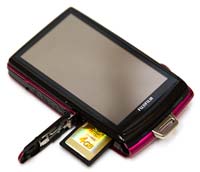 |
 |
| Memory Card Slot | Battery Compartment |
Recently Fujifilm released a new panoramic mode that allowed much easier alignment and stitching of pictures to create panoramas but it still wasn't as easy as the Sony Sweep Panorama. Motion Panorama is Fujifilm's answer to Sweep Panorama. It takes a series of images while you move the camera in the direction you want to record. It also features a yellow line to keep you aligned. The menu is still easy to use though, it's just evolved to a more advanced state of the extremely simple menu systems that they became famous for a few years ago.
The Z1000EXR has an extensive array of options in its Playback menu The picture is displayed in the center of the touch screen with ten buttons down the sides of the picture in 2 groups of 5. From this point it's possible to favorite pictures your by giving them a star rating, search for pictures using date, face recognition information (faces have to have been registered in the camera database before this will work), favorites, scene mode, type of data or by upload mark (YouTube or Facebook).
Along with the camera, inside the box you'll find a rechargeable lithium ion battery and a dedicated charger which comes with a 3 pin attachment that slides on to the charger. The lack of lead could reduce the amount of places that it can be plugged in due to its size and shape. There's also a USB lead and small wrist strap to prevent the camera from being dropped. In the software package there's a paper based quick start guide, warranty booklet and on the driver CD is MyFinePix Studio for both Windows and Mac. The full owners manual is also on the disc.
Fujifilm FinePix Z1000EXR Review

Main Features
- 16MP – 1/2″ EXRCMOS Sensor
- ISO 100 - 3200( expands to 6400)
- 28-140 mm F3.9-4.9 Zoom Lens
- Sensor-shift Image Stabilization
- 3.5″ Fixed Type Screen
- 11 fps continuous shooting
- 1920 x 1080 v >157g. 102 x 60 x 18 mm

Fujifilm Z1000EXR Overview
First introduced in January 2012, Fujifilm FinePix Z1000EXR is a 16.0MP Small Sensor Compact camera with a 1/2″ (6.4 x 4.8 mm) sized EXRCMOS sensor.
Fujifilm Z1000EXR has an Overall Score of 44/100 and ranked #153 out of 627 in Compact cameras (Top 10 Compact), and ranked #623 out of 1190 in all Cameras (Top 10 Overall).
Fujifilm Z1000EXR Compared to other Compact Cameras
Now let's get in to more details of our Fujifilm Z1000EXR review by analyzing its specs and features and listing out its pros and cons compared to average competitor cameras in its class.
| Built-in Wireless (Wi-fi) |
| Image Stabilization |
| 1920 x 1080 Max Video Resolution |
| Touch Screen |
| Face Detection Focusing |
| Large 3.5″ Screen |
| 11.0fps Fast Continuous Shooting |
| 157g Light Body |
Buy Fujifilm Z1000EXR from AMAZON or B&H PHOTO
| No Articulating Screen |
| No External Flash Shoe |
| No Built-in Viewfinder |
| No RAW Shooting |
| Max Sensitivity only ISO 3.200 |
| Only Unknown Focus Points |
| Low Screen Resolution (460kdots) |
| Low Battery Life: 220 shots |
| No Manual Focusing |
| No Manual Exposure |
| No Environmental Sealing |
| Slow Lens at Wide: f3.90 |
| Slow Lens at Tele: f4.90 |
Fujifilm Z1000EXR has a 16.0MP 1/2″ (6.4 x 4.8 mm) sized EXRCMOS sensor. You can shoot at maximum resolution of 4608 x 3456 pixels with aspect ratios of 4:3, 3:2 and 16:9. Z1000EXR has a native ISO range of 100 – 3200 which can be boosted to 6400 but unfortunately, Fujifilm Z1000EXR doesn't have RAW file support. If you need a Compact camera with a RAW support, consider or in the same price range.
Fujifilm Z1000EXR is not the highest resolution Small Sensor camera. Kodak Astro Zoom AZ651 with its 21.0MP sensor is leading in this class. Check the comparison of Fujifilm Z1000EXR vs Kodak Astro Zoom AZ651 or take a look at Highest resolution Compact cameras list.
Let's look at how the size of the Fujifilm Z1000EXR's 1/2″ sensor compares with other standard sensor sizes.
FinePix Z1000EXR / Z1010EXR (Discontinued Model)

Specifications
FinePix Z1000EXR / Z1010EXR
| Model name | |
|---|---|
| Number of effective pixels *1 |
16.0 million pixels |
| Image sensor |
1/2-inch EXR CMOS with primary color filter |
| Storage media |
|
| File format |
JPEG (Exif Ver 2.3) *3 |
| Number of recorded pixels |
L : (4:3) 4608 x 3456 (16:9) 4608 x 2592 360° Vertical 7680 x 1080 Horizontal 7680 x 720 Fujinon 5 x optical zoom lens f=5.0 — 25.0 mm, equivalent to 28 — 140 mm on a 35mm camera F3.9 (Wide) - F4.9 (Telephoto) 11 groups 13 lenses |
| Digital zoom |
F3.9 / F6.2 (Wide) |
| Focus distance (from lens surface) |
|
| Sensitivity |
Auto, Equivalent to ISO 100 / 200 / 400 / 800 / 1600 / 3200 / 6400* (Standard Output Sensitivity)
|
| Exposure control |
TTL 256-zones metering Multi |
| Exposure mode | |
| Shooting modes |
Portrait, Portrait enhancer, Landscape, Sport, Night, Night (Tripod), Fireworks, Sunset, Snow, Beach, Party, Flower, Text, Dog, Cat |
| Image stabilizer |
CMOS shift type |
| Face detection | |
| Exposure compensation |
-2.0EV — +2.0EV 1/3EV step |
| Shutter speed |
(Auto mode) 1/4sec. to 1/2000sec., (All other modes) 4sec. to 1/2000sec. |
| Continuous shooting |
TOP : max 12 frames (3 frames/sec.) |
| Auto bracketing |
Single AF / Continuous AF (EXR AUTO, Movie) / Tracking TTL contrast AF Center / Auto area / Touch & Track (Touch & Track mode) / Portion of touch (Touch EXR Auto mode, Touch & Shoot mode) |
| White balance |
Automatic scene recognition Fine, Shade, Fluorescent light (Daylight), Fluorescent light (Warm White), Fluorescent light (Cool White), Incandescent light Approx. 10sec. / 2sec. delay, Couple Timer / Auto-shutter(dog, cat) / Auto release / Self portrait Timer Auto flash (super i-flash)
|
| Flash modes |
Red-eye removal OFF Auto, Forced Flash, Suppressed Flash, Slow Synchro. Red-eye Reduction, Red-eye Reduction & Forced Flash, Suppressed Flash, Red-eye Reduction & Slow Synchro. |
| LCD monitor |
3.5-inch wide, approx. 460,000 dots, TFT Color LCD monitor, Touch, approx. 100% coverage, aspect ratio 16:9 |
| Movie recording |
1920 x 1080 pixels / 1280 x 720 pixels / 640 x 480 pixels (30 frames/sec.) with stereo sound. |
| Photography functions |
EXR mode (Auto / Resolution priority / High ISO & Low noise priority / Dynamic range priority), Auto, High-speed movie(80 / 160 / 320 fps.), Dynamic range, Face Detection, Auto red-eye removal, Touch & Shoot, Face recognition, Film simulation, Motion panorama360, Auto release, Date stamp |
| Playback functions |
Face Detection, Face recognition, Erase selected frames, Auto red-eye removal, Image search, Crop, Resize, Image rotate, Slide show, Multi-frame playback, Edit, Mark for upload, Photobook assist, Favorite, Panorama, Face Retouch, connect to smartphone |
| Other functions |
PictBridge, Exif Print, 35 languages selection, Time difference, Silent mode Fujifilm FinePix Z1000EXR review Link to main publicationFor any suggestions regarding the site: [email protected]
|

